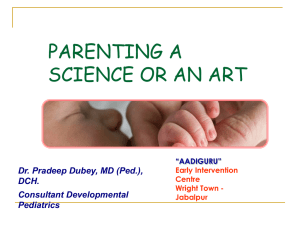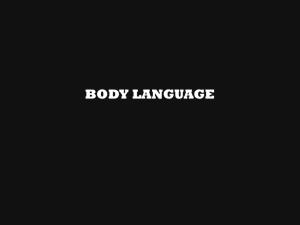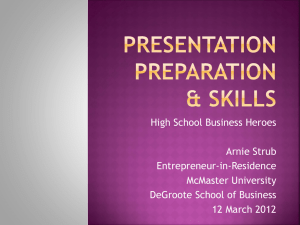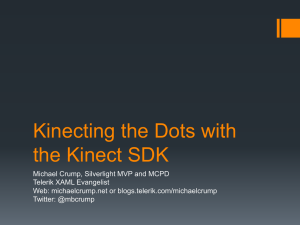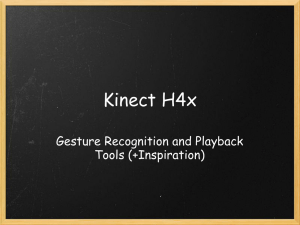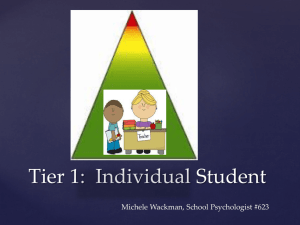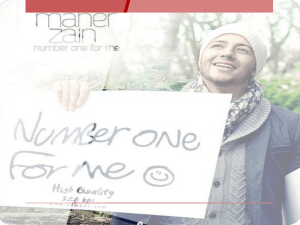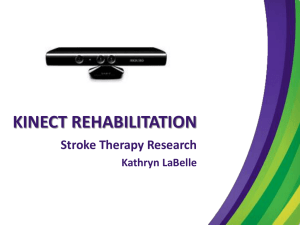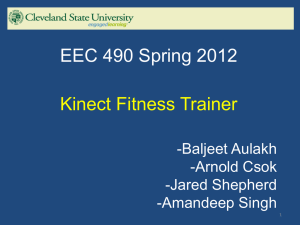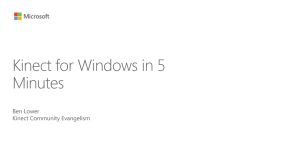pptx - mywr.net
advertisement
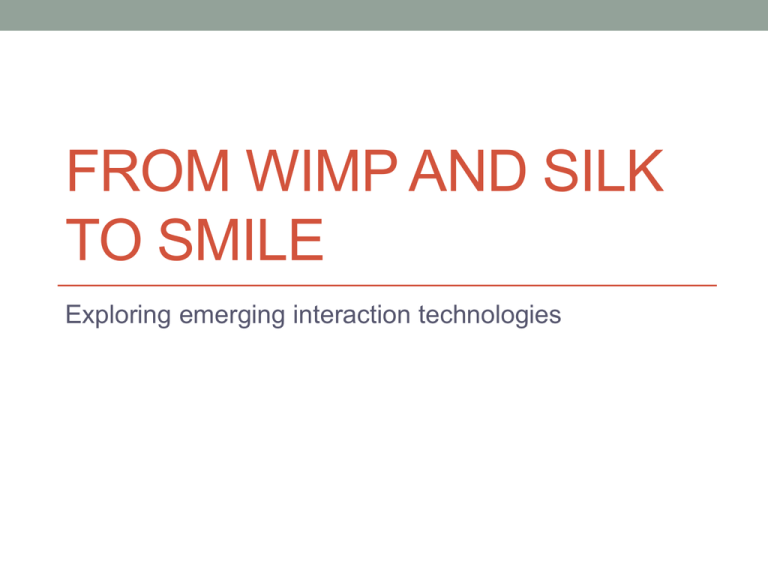
FROM WIMP AND SILK TO SMILE Exploring emerging interaction technologies Today’s topics • Understanding the rapid change of technology • Engaging in the Jurassic Park Test • Exploring some of the many new (=current) ways to interact with technology The world changes fast • Creative destruction (Schumpeter) • One economic development arises out of the destruction of an older • This goes for technology too • How many buy music? (CDs) • How many rent a video? (in a store) • We are moving from “hardware” (CD) to “software” (iTunes) to “services” (Spotify for music, Netflix for movies) • My first USB 2.0 memory stick was 128 MB • You can barely store more than the sound of “air” in good quality there The web changes fast • From being • World Wide Web • You sit by a home computer/laptop and browse web pages, using your keyboard and a mouse – or through your mobile • …we now have • A Web-Wired World • Where you always are connected • Where you interact in many new ways • Where you (and your phone) constantly transmit information • Fine, there are changes… • How can we exploit then for building better/more modern systems? Before we SMILE • Let us have a look at some technology changes • From “fatscreen” to “flatscreen” (change h/w <-> h/w) • From “local storage” to “cloud storage” (change h/w <-> service) • From “applications” (office, email) to “services (s/w <-> services) • Office 365, Google Docs, Dropbox • Changes come fast, and old technology is forgotten • READY TO DO THE JURASSIC PARK TEST? Jurassic Park test • Which of you know what happens when pressing this? • Which of you know what this symbol represents? • Those of you with your hands up, kindly pick up your SENIOR CITIZEN CARD when you leave this room... • ”John”, 13 ”...and then you have this symbol for saving. I don’t really know what it is but it is sort of square, with a somewhat bigger white area in the upper half...” More predictions • Remember this! • (Dialogue in 15 years) - - Daddy, have you ever used a keyboard? Sure I have! Why did you do that...? • This is the next generation, after you (watch out): • Anna, 2 years finds a glossy magazine. She immediately tries to ”change page” by swiping…without success. • She hands over the magazine to her mother, with eyes saying ”this device is not working…” Changes in paradigms • The 1980’s: WIMP • Windows – Icons – Menus – Pointers (or point-and-click) • We have lived by this paradigm for 35 YEARS!!! • The mid 1990’s: SILK (Reddy) • Envisioning what would lie ahead • Speech – Image – Language – Knowledge • We have, in part, seen S-I-L, but don’t see K (back-end) • Now: we must include all the new ways of interaction which are possible with mobile phones, tablets, consoles • You should start to SMILE SMILE • In an effort to cover most of the “modern” – and by all means, also traditional – modes of interaction we coined • Speech • Speaking to technology, and be spoken to by it • Movement • Mouse…ok, now swiping but also hands (gestures) • Image • Not only “photos”: “live” avatars, QR codes, face recognition • Language • Translations, and also “emotional” language • Environment • You, and your devices, interact…constantly SPEECH • Speech recognition: speak to your phone (SIRI; not very new) • Speech generation: TTS – text to speech – units speak to you • Emotions are also a language (MIT – Kismet – 1997) • http://www.youtube.com/watch?v=8KRZX5KL4fA • WAMI – speak to the Internet • http://groups.csail.mit.edu/sls/research/vehicle.shtml • Kinect – SpeechRecognitionEngine • http://www.youtube.com/watch?v=9lePgTpjRto • Experiments (Spring 2013): Stroop effect (WAMI och Kinect) • Classic psychology experiment: say the COLOR of the TEXT • BLACK BLUE RED BLUE RED GREEN BLACK BLUE BLUE BLACK Motion/movement • Catch movements in 2D, 3D - Move a mouse pointer, swipe a tablet - New ways to communicate (mostly 3D) - Sensor fixed, object moving (Kinect) - Sensor moving, object fixed (”scanning”, e.g. with Kinect) - Major movements (as GPS in mobile) is dealt with later • Experiments (2013) • Connect the dots • Kinect Fusion Image • Basicly: image analysis (detect patterns) • Image filtering (blue-screen) • Combine with scanning (interpret ”the surrounding”) • Beyond ”flat” image: 3D/holograms, as here (but not really…) • DVE: http://www.youtube.com/watch?v=Wl9og1O3onQ • Miku Hatsune: http://www.youtube.com/watch?v=dhYaX01NOfA • Experiment (2013/14) • ”The fake postcard” Language • Audio analysis • As speech, but for a different purpose • Also covers intonation and ”body language” • http://www.nextup.com/acapela.html • Tomorrow’s Google translate • http://www.youtube.com/watch?v=QFL0_LsZiYQ • For all you programmers: Google API (set language/text) • http://translate.google.com/translate_tts?tl=en&q=hello+computer+experts • Experiments (2013/2014) • ”Oh dear” – measure pulse, comfort Environment • Which means ”everything around us...” • In the new WWW we are transponders which constantly and without realising it (?) interact with our surrounding • • • Mobiles/GPS/Geo-location is only one, among many, exemples http://www.pathintelligence.com/ ”Smart” clothes is another • Smartphones have geo-location, but not Kinect • Connecting to WiFi brings the node’s position Experiment (2013/2014) Live battlegrounds (3-5 meters accuracy indoors, 20 m outdoors) http://www.navizon.com/indoors-solutions http://www.pacmanhattan.com/ WHAT? Not the end? • Beyond SMILE we also have AH (as in AH, SMILE!) • Data forms also change (more than e.g. audio) • We are used to graphics, sounds, printouts • A as in ARTIFACT (”things”) • 3D printers are as low priced as 400 EUR (and up) • http://www.creativetools.se/hardvara/3d-skrivare?sort=p.price&order=ASC • • Are you cold my son? Let me print you a sweater... We have been dating for three months. I printed these flowers to you but they had to be blue; I ran out of red ink… • H as in HAPTIC (touch) • • Anyone who remembers FORCE FEEDBACK games? Mobile phones that VIBRATES are also feedback Why is this important? • Ask yourselves: • In all the time you spend using the Internet during an average day and night, how much is spent in front of a computer screen (as compared to using mobile phones/tablets)? • So, how do you think “tomorrow’s consumers” (you and younger generations) will interact with the WWW? • Then why concentrate on developing traditional websites? Class discussion • Form groups of 3-5 students • Discuss a new idea (“mental prototype”) which will build on one or more of the SMILE technologies • Who is if for? • Where and how will it be used? • What is the value for the user? • You have 15 minutes Summary • New technology is pushing, our demand pulling • WIMP and SILK will still be around, but we (YOU!) must also be ready to AH, SMILE as means for interaction • The WWW is turning into WWW • Many applications will (should) be Mobile first
